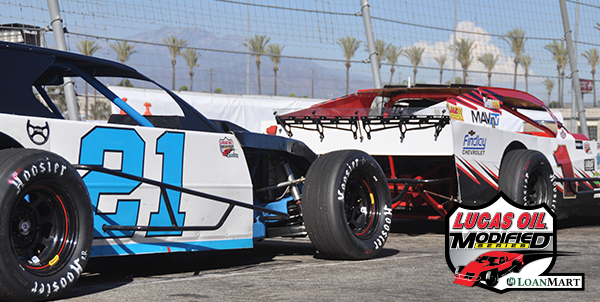
CORONA, California (January 27, 2014) – There's a saying in the retail business that the key to success is location, location, location. In auto racing the key is car count, car count, car count.
The more cars the better for the race tracks, the sponsors, the spectators and the racers, especially those in a regional touring series like the Lucas Oil Modified Series presented by LoanMart.
It's not surprising then that when they set down to talk about possible changes for the 2014 season series promoter Greg Scheidecker, race director Bill Rozhon and technical director Alan Brown focused on maintaining or improving last season's average of 30 cars per event.
"Keeping the car count up is the real issue," Scheidecker said. "That's what keeps our series alive. That's what keeps track promoters interested in our series, the car count we bring and the entertainment value we bring."
They addressed the issue by increasing the size of the main event starting fields for all 10 races on the schedule, increasing the K&N tow money and Hoosier Tire West points fund bonuses, revising the format and purse structure for the iON Camera B mains and adopting a format that will make more drivers eligible for the BILSTEIN Trophy Dashes.
Series officials discussed increasing the main event starting fields with the managers of the six tracks that host Lucas Oil Modified races and got unanimous support for the idea.
As a result, the fields will increase by two cars at Havasu 95 Speedway (22 to 24) in Lake Havasu City, Arizona; Lucas Oil I-10 Speedway (22 to 24) in Blythe, California; LoanMart Madera Speedway (24 to 26) in Madera, California; and Rocky Mountain Raceways (26 to 28) in West Valley City, Utah. There will be 28 starters at Tucson Speedway in Tucson, Arizona, which returns to the schedule, while The Bullring at Las Vegas Motor Speedway will start 26 cars (up from 24) at its May event and 30 instead of 26 for the season-ending race in November. The Irwindale Events Center also is adding four cars to the field and will have 30 starters.
At every event the field will include four provisional starters based on the point standings and four cars from the revamped B mains, which will be either 20- or 40-lap races depending on the number of cars.
If there are 12 cars or more that fail to qualify on time the B main will be a 40-lap contest divided into two segments. The top four cars after 20 laps will pull off the track and transfer to the main event. The remaining cars will run another 20 laps, with the winner of that segment taking home $300 and everyone getting at least $100. With fewer than 12 cars the B main will 20 laps with the top four transferring and the fifth-place driver collecting $300. All those not transferring also will get 8 points in the Hoosier Tire West point standings.
Those 8 points could prove to be extremely valuable, too, because Hoosier is adding money to the points fund bonuses the drivers finishing 11th through 15th will receive at season's end and the teams will receive more in this year's two-tier tow money program. Those in the K&N Winner's Circle, for the top 10 in the standings, will get a minimum of $250 per race, those in 11th through 20th will get $200, and those amounts will be doubled for the races at Tucson and Madera and tripled for the event in Utah.
The BILSTEIN Trophy Dash will have a different look, too. The fields for those 6-lap races have been the fastest half-dozen cars in qualifying. This season it will be on a rotating basis – 1-6 for the opening race, 7-12 for the second, 13-18 for the third and so on – with the winner still getting $200 and 2 bonus points.
What we're trying to tell these guys," Scheidecker said, "is that we've increased the bonus money and we've increased the potential laps you get to race because we want to retain our high car count. That's our focus. We don't want the 30th-place car not to come to our next race. That's why we're putting more money in to the iON Camera B-main."
There are no rule changes for 2014, but there is one more procedure change that series officials hope will address some of the concerns raised by the drivers when tires were discussed at a recent meeting.
This year, the tires that a driver races on at an event must have been purchased at that event, and all Universal Product Codes (UPC) will be checked during tech inspection before qualifying.
"We're excited that these rules will be sent to the new Northern California Modified racing series, to Kenny Shepherd at Madera and Tim Richter at Las Vegas and Dan Breach in Utah," Scheidecker said.
"Everyone has indicated that they want use our rules as a starting point or a baseline for their rules (for modified series'). Bill, Brownie and I very, very honored that our rules are good enough for them to recognize in that way."
The Lucas Oil Modified Series presented by LoanMart is supported by a potent marketing concept known as "Team Lucas" whose members include General Tire, GEICO, E3 Spark Plugs, Optima Batteries, Ole Smoky Moonshine, iON Camera, Speedco Truck Lube and Tire, BILSTEIN Shocks and SuperClean.
Additional sponsorship is provided by Lucas Oil Products, Protect the Harvest, MAVTV American Real, Hoosier Tire West, Sunoco Race Fuel, K&N Filters, Aero Racing Wheels, ASI Racewear, Bosch, Five Star Race Car Bodies, Frank's Radio, Racing Plus and DJ Safety.



